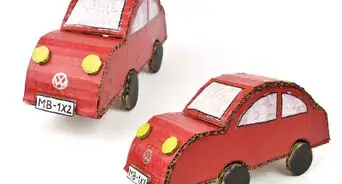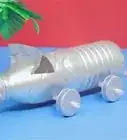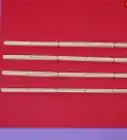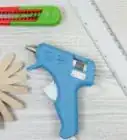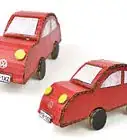This article was co-authored by wikiHow Staff. Our trained team of editors and researchers validate articles for accuracy and comprehensiveness. wikiHow's Content Management Team carefully monitors the work from our editorial staff to ensure that each article is backed by trusted research and meets our high quality standards.
There are 10 references cited in this article, which can be found at the bottom of the page.
The wikiHow Video Team also followed the article's instructions and verified that they work.
This article has been viewed 223,056 times.
Learn more...
Glitter, galaxies, fizz, and fun! Make potions with your kids and help them discover the joy of science! You can mix together different ingredients that you most likely already have at home to make fizzing potions, or combine paint, glitter, and cotton balls to create a galaxy potion that is bound to mesmerize! You can even make awesome color-changing potions by mixing cabbage water with vinegar!
Things You Should Know
- Make an easy fizzing potion by combining liquid dish soap, white vinegar, baking soda, food coloring, and glitter.
- Mix acrylic paints with water and add silver glitter to create a galaxy in a jar.
- Create a color-changing potion with cabbage water, baking soda, and white vinegar.
Steps
Making a Fizzing Potion
-
1Set up your potion-making workspace by assembling all your tools. To make a fizzing potion, you’ll need several glass jars or vials of various sizes. You’ll also need liquid dishwashing soap, white vinegar, baking soda, a spoon, food coloring, glitter, and other mix-in options for your potions. Have the kids make their potions on a large tray, like a baking sheet, so that the fizz will be contained easily.[1]
- If you don’t have liquid dishwashing soap, you could also use shavings of bar soap for the same effect.
-
2Fill each glass container 1/2 full of white vinegar. Make sure you are using clean glass containers. Have the kids carefully pour enough white vinegar to fill each container 1/2 of the way full.[2]
- Try to let your kid do as much of the pouring and mixing as they can! If they are younger, this activity can really help them practice their fine motor skills, and if they are older, it’s fun for them to take charge and create things!
Advertisement -
3Squeeze about 1 US tbsp (15 mL) of dish soap into each container. Have the kids add in the liquid dish soap to the containers full of white vinegar. If your glass containers are very small, add closer to 1 teaspoon (4.9 mL) of soap. The more soap that’s added, the fizzier the potion is going to be![3]
- The dishwashing soap is going to make the potion super bubbly! If you don’t have liquid dishwashing soap, you could also put 1 or 2 shavings of regular bar soap into the container for a similar effect.
-
4Add a few drops of food coloring to each container. Depending on how light or dark the kids prefer the potions to be, have them add anywhere from 2-6 drops of food coloring. They could mix colors together, or just use 1 color for a bright, vibrant potion.[4]
- If the kid decides the potion is too light, simply have them add another few drops of coloring in.
- You could also try your hand at making natural food coloring to use in your potions.
-
5Mix in glitter, gemstones, or other add-ins to the containers! This is where the kids can get really creative. For a “fizzing fairy potion,” have them add glitter and gemstones and even colored sprinkles. For a “witches brew potion,” they could add dry beans (black beans could be spider eggs and lima beans could be frog warts) or other food items.[5]
- Have each kid create their own mix and ask them what kind of potion they are making to encourage creativity.
-
6Stir up each container really well with a spoon or stick. Depending on the size of the container, have the kids use either a spoon or a wooden skewer to mix together the vinegar, soap, and mix-ins.[6]
- Don’t stir the containers too vigorously. You want to mix the ingredients together, but you don’t want to make the mixture too soapy or frothy yet.
-
7Put a large spoonful of baking soda into each container. Make sure the glass containers are on top of the baking tray so that the fizz will be contained, and have the kids add the baking soda to their potions. For a mason jar sized container, use about 2 tablespoons (30 mL) of baking soda.[7]
- If you are using a container that has a small opening, like a chemistry flask, you may need to use a funnel to get the baking soda into the container.
-
8Watch as your potion fizzes up over the top of the container! As soon as you add the spoonful of baking soda, watch as your potion begins to fizz! It should overflow and go down the sides of the container, carrying some of those mix-ins along with it.[8]
- The reaction between the vinegar and baking soda creates a gas called carbon dioxide, which is what makes the bubbles and fizz in your potion.
Creating a Galaxy in a Jar
-
1Prepare your galaxy-making station. Cover your work area with old newspaper, fill a large pitcher with water, and set out your glass container, cotton balls, acrylic paints silver glitter. You could also purchase small, silver, glittery stars to add into your galaxy. You’ll need at least 3 different colors of acrylic paint.[9]
- You need a lot of cotton balls! Depending on how large your container is, you may need as many as 3 or more bags, so consider buying a large bulk bag with 1000 cotton balls so you know you’ll have enough.
- Make sure to use a glass container that has a lid.
- You can buy all of these supplies at your local craft store.
-
2Fill your glass jar 1/3 of the way with water. Make sure the glass container is clean before you start making the galaxy potion. Then, have the kids pour enough water to fill the container 1/3 of the way full.[10]
- Kids of any age will enjoy making this potion! It’s also a fun group activity for birthday parties!
-
3Add about 1 tablespoon (15 mL) of acrylic paint to the water. The kids can squeeze the paint into the water directly, or you could have them squeeze it onto plastic spoons and then stir it into the water. Either way, make sure the water and the paint get mixed together.[11]
- Each kid can make the water as light or dark as they prefer—just add more paint for a deeper color versus just a few drops for a pastel tone.
-
4Shake in some silver glitter to create the galaxy. This is one of the most fun parts of potion making—adding in glitter! The kids can spoon, shake, or pinch glitter and add it to the colored water. If you also purchased silver stars, now is the time to add them![12]
- Silver glitter shows up really well even through dark water, but you can also use gold or multi-colored glitter.
-
5Pull apart your cotton balls and add them to the jar. Have the kids stretch the cotton balls so they are long and wispy. Then have them add the cotton balls to their containers until most of the water is absorbed. They may need to use a spoon or wooden stick to poke the cotton down all the way.[13]
- Make sure to use cotton balls rather than cotton swabs. The swabs are too concentrated and won’t create the same effect in the jar.
-
6Pour more water into the jar and add a different color of paint. Once the majority of the first layer of water and paint has been absorbed by cotton balls, add more water until the jar is 2/3 of the way full, and add in about 1 tablespoon (15 mL) of a different color of paint. For example, if your first layer was dark blue, make the second layer pink.[14]
- Use a spoon or wooden stick to gently mix together the second layer of water and paint.
-
7Repeat the glitter, cotton, water, and paint steps until your jar is full. Soak up that second layer of paint and glitter with stretched out cotton balls, and then create a third layer with another color of paint and repeat the process. When you’re done, the jar should resemble a multi-colored, glittery galaxy.[15]
- You could even give the jar a few quick shakes to slightly mix together the colors for a more integrated look.
-
8Tighten the lid on your jar and use it as your galaxy potion when playing. This is a great potion to have if you like to play “scientist.” You can leave it closed up, or your kids could even open it up and take out some of the cotton to add some “galaxy” to their other potions.[16]
- If you’re sending galaxy potion jars home with kids for gifts, make sure the lids are screwed on really tight. Also, you could write each kid’s name on the bottom of the jar in permanent marker so they don’t mix up which galaxy belongs to which kid.
Mixing Color-Changing Potions
-
1Prepare your workstation before starting your potion making. You will need 4 glass containers for each kid, baking soda, white vinegar, and spoons. You can also put the containers on a baking tray so that any potential mess will be easily contained.[17]
- Use containers that have lids so your kids can save the potions to play with again later.
-
2Make cabbage water by boiling a cabbage and steeping it for 30 minutes. You can use any size of cabbage for this process. Simply put it into a pot on the stove, add enough water to cover the cabbage, let it come to a boil, and then remove it from the heat and let it sit for 30 minutes. After 30 minutes, pour the water in a jar, passing it through a sieve first.[18]
- No need to cut up the cabbage! You can boil it whole.
-
3Pour the cabbage water into 4 different glass containers. In the first container, fill it up all the way with cabbage water. In the second container, fill it 3/4 of the way full. In the third container, fill it 1/2 way with the cabbage water, and in the fourth container, only fill it 1/4 of the way full.[19]
- Your cabbage water may be blue or it may be pink! Either way, the experiment will work.
-
4Add water to dilute the cabbage water in the last 3 containers. Add enough water to fill each container nearly to the top. Each container will now have a different shade of cabbage water.[20]
- Leave a little bit of room at the top of each container, so that there is space to add in the other ingredients.
-
5Mix 1 teaspoon (4.9 mL) of white vinegar into each container. Have your kids measure out the vinegar and pour it into one container at a time. Watch as the color changes instantly![21]
- You could even have the kids use an eyedropper for a more authentic potion-making experience.
- The vinegar is an acid, which reacts with the cabbage water, which is an indicator, and that is why the color changes.
-
6Put 1 teaspoon (4.9 mL) of baking soda into each container. Watch as the cabbage water bubbles and changes color again! If you’re concerned about foam getting all over your workspace, do this step on top of a baking tray or paper plate.[22]
- The baking soda is an alkaline, which also reacts to the acidity in the vinegar and the cabbage water.
-
7Continue mixing in vinegar and baking soda to make even more colors! Your kids can keep adding vinegar and baking soda in turn to create more colors and reactions.[23]
- If you need to, dump out a little of the cabbage water to make more room for the other ingredients.
Community Q&A
-
QuestionHow do I make a fun and easy explosion?
 Community AnswerMixing malt vinegar with bicarbonate of soda (baking soda) will create an eruption.
Community AnswerMixing malt vinegar with bicarbonate of soda (baking soda) will create an eruption. -
QuestionCan you make the potions easier?
 Community AnswerYou can simply add glitter, color, scents, and powder to soap and water with no measurements required.
Community AnswerYou can simply add glitter, color, scents, and powder to soap and water with no measurements required. -
QuestionWhere do I get the materials for this?
 Community AnswerYou can get the glitter from a craft store and the soap from your local drug store and the jars from the supermarket.
Community AnswerYou can get the glitter from a craft store and the soap from your local drug store and the jars from the supermarket.
Things You’ll Need
Making a Fizzing Potion
- Liquid dishwashing soap
- White vinegar
- Baking soda
- Food color
- Glitter
- Jars of various sizes
- Baking tray
- Spoon
Creating a Galaxy in a Jar
- Newspaper
- Glass container with a lid
- Acrylic paints
- Cotton balls
- Glitter and stars
- Wooden stick for stirring
Mixing Color-Changing Potions
- Cabbage
- Pot
- Sieve
- Glass containers
- Spoon
- Baking tray
- White vinegar
- Baking soda
References
- ↑ http://redtri.com/pretend-magic-potions-kids-can-make/slide/8
- ↑ https://youtu.be/f3gUhNrFRc4?t=95
- ↑ https://youtu.be/f3gUhNrFRc4?t=125
- ↑ https://youtu.be/f3gUhNrFRc4?t=150
- ↑ https://youtu.be/MfZmziCo9gk?t=61
- ↑ https://youtu.be/f3gUhNrFRc4?t=216
- ↑ https://youtu.be/f3gUhNrFRc4?t=245
- ↑ https://youtu.be/f3gUhNrFRc4?t=304
- ↑ https://www.momdot.com/diy-nebula-jar-instructions/
- ↑ https://www.momdot.com/diy-nebula-jar-instructions/
- ↑ https://www.momdot.com/diy-nebula-jar-instructions/
- ↑ https://www.momdot.com/diy-nebula-jar-instructions/
- ↑ https://www.momdot.com/diy-nebula-jar-instructions/
- ↑ https://www.momdot.com/diy-nebula-jar-instructions/
- ↑ https://www.momdot.com/diy-nebula-jar-instructions/
- ↑ https://www.momdot.com/diy-nebula-jar-instructions/
- ↑ https://theimaginationtree.com/magic-colour-changing-potions-science-activity/
- ↑ https://theimaginationtree.com/magic-colour-changing-potions-science-activity/
- ↑ https://theimaginationtree.com/magic-colour-changing-potions-science-activity/
- ↑ https://theimaginationtree.com/magic-colour-changing-potions-science-activity/
- ↑ https://theimaginationtree.com/magic-colour-changing-potions-science-activity/
- ↑ https://theimaginationtree.com/magic-colour-changing-potions-science-activity/
- ↑ https://theimaginationtree.com/magic-colour-changing-potions-science-activity/
-Step-1-Version-5.webp)
-Step-9-Version-5.webp)
-Step-17-Version-4.webp)
